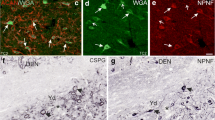Abstract
We have used carbocyanine dye tracing techniques in conjunction with photoconversion and electronmicroscopy to examine the prenatal development of the central and peripheral processes of those vestibular ganglion cells projecting to the cerebellum. Developmental changes in the number of vestibular ganglion cells were assessed in paraffin-embedded material by nucleolar counting. In agreement with the results of parvalbumin staining, afferents to the cerebellum from the vestibular ganglion pursued a superficial course during early fetal life (E13 to E15). From E16 to E19, this superficial position was progressively lost and vestibulocerebellar fibres were seen to be directed towards the ventricular surface (prospective posterior/inferior vermis). The change in the course of vestibular afferents to the cerebellum coincided with a profound reduction in the number of ganglion cells which could be retrogradely labelled from the cerebellar anlage (mean ±SD: E16–2040±1130; E19–510±440). During that same period the total number of vestibular ganglion cells rose to peak at a mean of 9200 at E19, although there was a subsequent decline to an average of 4660 at P0. This population size was maintained through to adult life (4600). We also examined the development of connections between the vestibular gangion and the vestibular apparatus. Peripheral processes of vestibular ganglion cells invaded the macula utricle and saccule and cristae of the semicircular canals from E13. We found that the peripheral vestibular ganglion cell processes themselves did not show any significant morphological changes from E16 to E21, but the sensory epithelium itself adopts a mature pseudostratified appearance by E21. This suggests that the loss of vestibular ganglion cells from E19 to birth is not related to major morphological changes in the peripheral axons, at least as revealed by carbocyanine dye labelling of these from the cerebellum, but may be associated with differentiation of the sensory epithelium to the mature pseudostratified form. Electronmicroscopy of photoconverted vestibulocerebellar fibres showed that at E14 these afferents were grouped in tight bundles of up to 20 axons. No particular association with the superficially placed external granular layer cells was found at that age. By E16 photoconverted vestibulocerebellar axons were no longer as tightly bundled and could be seen coursing more ventrally through the cerebellar anlage. The findings indicate that vestibulocerebellar fibres are not likely to physically facilitate external granular layer migration, since they do not attain a particularly close structural association with those cells. The observed developmental changes in the number of vestibular ganglion cells projecting to the cerebellum and the total number of vestibular ganglion cells suggests that changes in the course of vestibulocerebellar fibres are associated at first with retraction of cerebellar afferents, and subsequently with developmental cell death in the ganglion.
Similar content being viewed by others
Author information
Authors and Affiliations
Additional information
Accepted: 3 March 1998
Rights and permissions
About this article
Cite this article
Ashwell, K., Zhang, Ll. Prenatal development of the vestibular ganglion and vestibulocerebellar fibres in the rat. Anat Embryol 198, 149–161 (1998). https://doi.org/10.1007/s004290050173
Issue Date:
DOI: https://doi.org/10.1007/s004290050173




